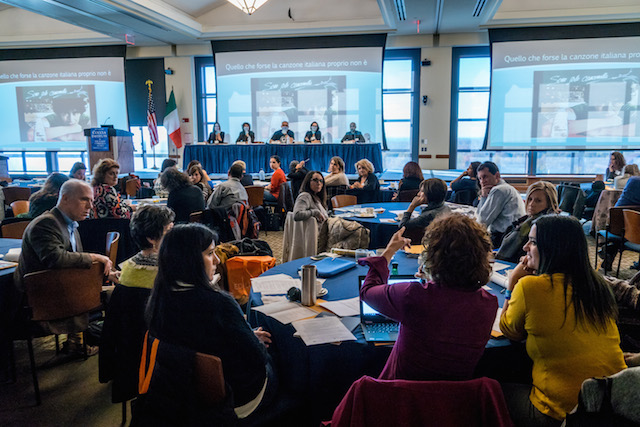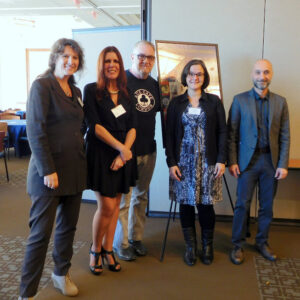The breathtaking view from the conference center at Montclair State University was the backdrop of Teaching Italian–A Symposium/Workshop for Instructional Materials Meeting IX: EduMusica, held on November 4th. This signature event of the Italian program of the Department of Spanish and Italian, and the Coccia Institute for the Italian Experience in America aimed to celebrate the teaching of Italian language and culture through music and songs, included an intriguing keynote address on the creative use of language, an engaging panel discussion responding to questions from the audience, and collaborative multiple workshops that presented the utilization of the Italian language in different art forms. Experts in the pedagogical uses of songs in the curriculum were Beppe Cavatorta of the University of Arizona, Mario Costa of Fiorello H. LaGuardia High School, Ilaria Serra of Florida Atlantic University, and Lillyrose Veneziano Broccia of the University of Pennsylvania.

Symposium Chair, Prof. Enza Antenos, set the theme for the entire event. She warmly welcomed everyone and acknowledged how much has changed since the symposium’s very first event in 2008, a now annual program co-organized with Dr. Mary Ann Re, Director of the Coccia Institute for the Italian Experience in America. “The beauty and wealth of Italian language and culture have provided an organic evolution of this program, and today we celebrate the language in its most natural artistic expression: song and music.” Prof. Antenos’ elucidation of the symposium’s evolvement helped instill a sense of excitement in new and returning participants. After her remarks, the audience’s antennae were up, ready to capture and feel the cultural beauty of Italian through songs and music. “How serendipitous that Bob Dylan was awarded the Nobel Prize for literature the year we showcase Italian music in the curriculum, — she proclaimed — music and songs, Nobel Prize for literature, the ‘cool’ factor of Italian: This symposium tops the charts!”

A key component of the symposium is the hands-on workshop. Facilitators provided examples of unit plans and offered tools to assist in the co-constructing of materials that could be adapted seamlessly and used immediately in the curriculum. Each workshop leader presented in his/her area of expertise, and the sessions furnished great stimuli in the materials creation process. Beppe Cavatora’s workshop, “Come sboccia una canzone. Unità didattiche costruite intorno a una canzone,” developed unit plans based on higher cultural concepts, from the Italian Constitution through Ligabue’s Non ho che te to everyday settings and interactions in certain environments such as a supermarket, influenced by the use of songs. Ilaria Serra’s “Le canzoni della storia” explored the connections between music and history, and asked participants to explore how the two provide an understanding of the historical period via a single song, integrating Italian language and culture of that era. Mario Costa’s workshop, “Clippassione! How to instruct the creation of a music video clip,” provided the flipside of using music to teach Italian. Students study and interpret Italian songs, from opera to hip hop, they explore embedded cultural references within those media forms, to produce and star in their own music videos. Lillyrose’s Veneziano Broccia’s “Music to Our Ears: Project-Based Approaches to Tuning Up Italian Language and Culture through Differentiation” provided a framework for teaching to address students interests and talents, thus motivating them through music to meaningfully interact with Italian, starting with a fun activity based on Jovanotti‘s Come parli italiano.

Since 2010, this signature event has been the venue for the Coccia-Inserra Award for Excellence and Innovation in the Teaching of Italian (K-12). This year, this $5,000 award — half for the recipient’s professional development and half for enrichment activities and cultural field trips for his/her or the recipient’s students of Italian — offered generously by Elda and Elisa Coccia and Lawrence Inserra, Jr., was presented to Gina Gallo, outstanding teacher of Italian at Bristol Central High School, Bristol, Connecticut. Gina’s superintendent wrote: “We could not be more proud of Gina. Her light shines so brightly and humbly.” Dr. Mary Ann Re recognized all those involved with the selection of the recipient: “The unenviable task of selecting the recipient rested once again in the capable hands of our ‘blue ribbon panel’ of judges, chaired by Distinguished Professor Anthony Julian Tamburri, Dean of the John D. Calandra Italian American Institute. Grazie mille, Prof. Andrea Baldi (Rutgers University), Dirigente scolastico Carlo Davoli (Consulate General of Italy in NY), Prof. Roberto Dolci (Università per Stranieri di Perugia) and Prof.ssa Clorinda Donato (California State University, Long Beach).”

Consul General Francesco Genuardi also attended the symposium, to officially meet with Dean Robert Friedman of the College of Humanities and Social Sciences to confirm the serious intention of Italian institutions to strengthen ties with Montclair State, an important institution that is a laboratory for the future of Italian. Consul Genuardi addressed participants and guests with his usual grace and charm, thanking everyone engaged in the teaching and promotion of Italian in the tristate area: “The rising numbers of AP students is also largely due to your activities here in New Jersey. It is a sign of the quality of the teaching of Italian, and I know that after this kind of professional development opportunity today, the quality will be strengthened even more. — he continued — New Jersey is a goldmine for Italy, a sophisticated, important state from a cultural and economic point of view. New Jersey is rich of Italians, of Americans of Italian descent and of Americans who love Italy. As they say of New Jersey, one of two is Italian, the other wants to be Italian.”
Symposium participants found the program not only fun but also thought-provoking, keeping with its tradition. George Clark an Italian teacher at Parsippany Hills High School and Montclair State alumnus commented the value of the symposium lies in that “it’s the only professional development program we have here in the state of New Jersey that allows the teaching of the language. This symposium, dedicated exclusively to the teaching of Italian, is the reason I’ll always come back every year.” Barbara Borghi of Pascack Valley High School and 2014 award winning teacher expressed how “this symposium in addition to providing a quality professional development program is about giving value to what we do, which is something difficult to be found in this area.”
Angela Mangione-Borelli of Long Branch High School and teacher of Italian of 42 years, and Antonia Gazillo of Hazlet Middle School now in her 7th year of teaching, are regular participants of the program also happen to be a mother and daughter. Both had similar opinions on the uniqueness of the symposium. “I like coming to each symposium, because I learn a lot from them — Angela declared.— This is a wonderful event for me, because it serves as an exchange of ideas as well as provides me with a refreshing course of new and exciting ideas.” Antonia added: “I come to the symposium every year, because I want to learn about new pedagogically sound methods and techniques.” In its 9th iteration, it has stayed true to its initial objective, stated Tess Iannacco, a seasoned Italian teacher of 16 years who has taught from elementary to AP Italian. “This is the ninth symposium I’ve had the privilege to attend. In my opinion, I find each symposium more interesting than the last and I always learn something new.”
The symposium’s tradition of embracing Italian language and culture, this year through the successful integration of music and song in the curriculum, will continue to shape its future. Teachers and students gather at these events to receive this knowledge from experts in the field and one other, and the tristate area maintains the Italian language and culture to be relevant and cool. The reactions of attendees serve as evidence that the spirit that circulates in the symposium will remain healthy through sharing and developing fresh ideas. “I do believe that this program, which has been enhanced year over year on the basis of registrants’ qualitative and quantitative evaluations, is an important developmental experience — concluded Dr. Mary Ann Re — and one I am proud to promote as a signature collaborative program between the Italian department and the Coccia Institute.”
And at the end of each symposium, a new one enters the state of conception, so we duly mark our calendars for the 10th symposium, a decade of Teaching Italian: October, 20th 2017.











